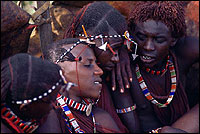By now, the region of East Africa appeared ripe
with potential to the British for taking it over. The topic stirred
an unusual amount of passion, conscience, and debate among the British
political parties and the ruling classes. In the end, an overpowering
sense of Victorian pride and scientific inquiry led the British
to take a lead role in the exploration. The British consul from
1873 to 1886 was John Kirk (1832-1922), who advised Sultan Barghash
to raise an army and annex most of eastern Kenya and Tanzania. Refusing
this advice, the sultan was helpless in the face of European territorial
imperialism. German imperialists led the way, and their claims were
upheld at the Congress of Berlin.In 1886 the British recognized
the German sphere of influence over coastal Tanganyika (part of
present-day Tanzania), retaining the Kenya area for themselves.
A further territorial division took place in 1890.

In 1887 the Imperial British East Africa Company (IBEA) was founded
with its headquarters in Mombasa. Officers from the IBEA immediately
began to establish outposts throughout the Kenyan interior. They
carried with them a flag bearing the motto "Light and Liberty,"
signifying the anti-slavery sentiments of the day. Between 1888
and 1890 a contingent of British officials and soldiers cut a 500-kilometre-long
dirt road to a swampy, flat area called Nyrobi by the Maasai, meaning
"place of the cold waters." Fort Smith was built nearby
as a British fortress and upcountry outpost.
The Imperial British East Africa Company also played a critical
role in the eventual development of a railway from Mombasa to Lake
Victoria. In 1902 all Kenya became a dependency under the Colonial
Office. It became the British base of operations in the protracted
East African campaign against the Germans during World War I.

The
type of government established in Kenya was the crown colony system.
The governor and the secretariat were appointed from London. Most
Africans, however, continued to be ruled in some fashion by their
own leaders under the general guidance of a British district officer.
Tribal lands were guaranteed, but all unoccupied territory became
crown land. Even before 1900 some white colonists had recognized
the economic value of the highlands and had begun to settle the
fertile lands adjacent to Nairobi. By the close of World War I more
than 9000 Europeans were in Kenya, and much of the highlands had
been reserved for continual white settlement. The government, claiming
to be concerned with "native paramountcy," actually favored
the productive white minority. African economics and politics were
closely monitored at a time when the depression of the 1930s and
an expanding population showed the inadequacy of the land reserved
for the natives.



